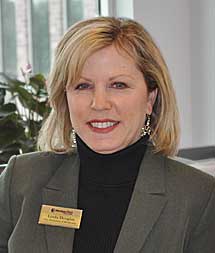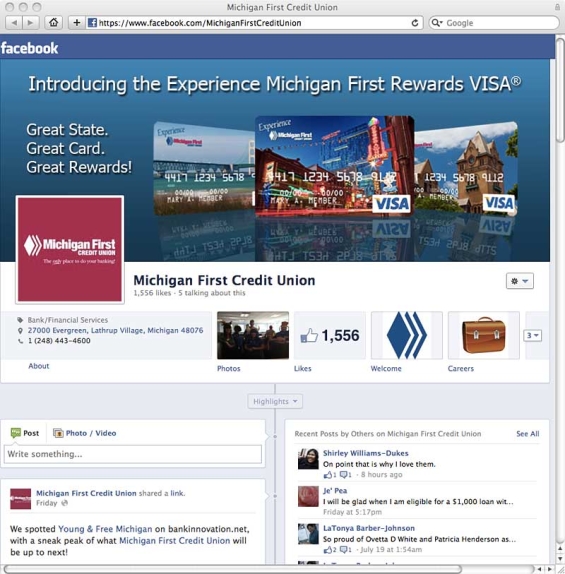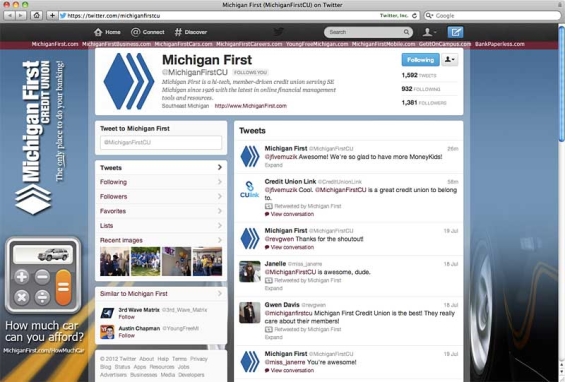The Financial Brand sat down with Linda Douglas, VP/Marketing at Michigan First, to talk about her credit union’s social media strategy, what works, what doesn’t and why they created a new, full-time social media position.
Website: www.michiganfirst.com
Assets: $625 million
Members: 86,000
Facebook: MichiganFirstCreditUnion (1,556 fans)
Twitter: michiganfirstcu (1,381 followers)
YouTube: michiganfirstcu
LinkedIn: Michigan First
Flickr: michiganfirst
When did the credit union first engage in social channels? Who managed it at the start?

Linda Douglas, VP/Marketing
Linda Douglas, VP/Marketing: Michigan First entered the social media landscape in April 2009, to coincide with the rollout of our newly enhanced online banking service. Social media channels were an integral part of sharing the news of this new service with embedded personal financial management capabilities. When Michigan First created our initial social media accounts on Twitter and Facebook, the day-to-day management of these channels was handled in partnership with the credit union’s public relations agency. The internal team worked hand-in-hand with our agency to develop a weekly editorial calendar and provide ongoing content for our accounts. Our agency provided ongoing monitoring and contributed relevant third-party content.
How many employees are in Michigan First’s marketing team? How many have social media duties?
Douglas: In total, the Michigan First marketing team now includes nine full-time team members. I serve as the vice president of marketing, and recently restructured the group to include two functional teams with different leaders. The digital experience manager (DEM) oversees our websites, email programs, and digital marketing along with social media. The marketing experience manager (MEM) oversees all non-digital aspects of marketing. The DEM has two direct reports – a digital marketing specialist, and our new social media specialist. The MEM has four direct reports including the Young & Free Michigan spokester. While everyone on both teams has some amount of involvement with social media, there are five team members with more significant social media roles. The social media specialist has primary responsibility for our social media accounts on a day-to-day basis and her two leaders (the DEM and VP) are involved strategically. The digital marketing specialist contributes creatively to our social media channels, and the Young & Free Michigan spokester manages our Young & Free social media accounts.

Move the Needle from Attrition to Acquisition
Vericast’s 2024 Financial TrendWatch explores seven of today’s most critical financial services trends to provide a complete view of the current loyalty landscape.
Read More about Move the Needle from Attrition to Acquisition

Fractional Marketing for Financial Brands
Services that scale with you.
When did the credit union decide it was finally time to hire a dedicated, fulltime social media employee?
Douglas: Over the past 24 months, social media has become a key part of nearly every activity within Michigan First. Whether we are promoting a new service, searching for new talent, showcasing our community involvement or recognizing our great employees at an event, we’ve made a concerted effort to ensure that social media plays an important role. As a result, we needed the right individual to not only oversee our existing efforts, but also identify new platforms and technology that align with our culture and our business goals. This newly created role was added to our roster as part of our 2012 planning process, and the position was filled in May, 2012.
What is this person’s title, job description and full range of responsibilities?
Douglas: Janelle O’Hara currently serves as our social media specialist at Michigan First. Her primary responsibility is to participate in strategizing, monitoring and identifying trends; and implement tactics to drive brand awareness and build loyalty among current members. She is also responsible for serving as both an internal social media evangelist and an advocate for our culture, mission, vision and values within public channels.
On a day-to-day basis, Janelle monitors conversations related to Michigan First while managing social media content and multimedia on both public channels and internal sites. She also produces video content and serves as the primary social media liaison between Michigan First and our integrated public relations agency.

The credit union joined Facebook on April 24, 2009 as part of its “Young & Free” spokester search. These days, they pick up between 3-7 new ‘Likes’ per week.
What prior experience or expertise was the credit union seeking in this new person?
Douglas: Our goal was to identify an individual who possessed not only an astute understanding of the social media landscape, but also a strong appreciation of the credit union and our audiences. We also wanted someone with a creative approach to problem solving and customer service. Since the social media world moves very quickly, we need to address issues and obstacles with speed and precision. Moreover, our members who are active in social media typically have high expectations regarding customer service. We also felt it was important to find someone with strong conversational writing skills to speak in our brand voice in a highly relatable way.
Our social media specialist serves as the “first line of defense” to address member questions, comments and concerns as they appear and to direct specific issues to the appropriate credit union team.
Janelle also serves as an active internal voice, helping to find and share interesting stories about Michigan First – from member testimonials to quick video demonstrations of our unique member-focused technologies.

For the person Michigan First selected for this role, what is their professional background?
Douglas: In 2011, Michigan First partnered with Currency Marketing to introduce the new Young & Free Michigan program. Janelle was selected as our first spokesperson and spent 12 months creating content and attending events on behalf of our organization. We were very impressed with her ability to manage multiple social media channels and connect the Michigan First brand to the content she was creating for the Young & Free Michigan audience. She also carved out a distinctive voice for the Young & Free Michigan brand, and developing a broader voice for the credit union’s social media efforts is one of our largest hurdles.
Additionally, Janelle has a very strong background in multimedia and video production. She earned her Bachelor’s degree in Mass Communication with a concentration in Television and Video Production. Since we regularly include video as part of our social media efforts, it made perfect sense to enhance our internal production capabilities.
What are the credit union’s goals and objectives for social media going forward?
Douglas: Looking ahead, we’re actively seeking out new opportunities to incorporate social media into other areas of the credit union. We’ve been actively leveraging social media for product launches, marketing programs and community relations for several years; but we see a distinct opportunity to extend our social media focus to help other credit union teams achieve their goals. For instance, teaming with human resources to expand our recruiting efforts on social media, and extending our business-to-business efforts. We’re currently working with these groups to formalize social media best practices that apply specifically to their areas and are tied to their objectives.
Our plan is to provide these teams with a more prominent seat at the table as our program grows. The advantage of having a dedicated social media specialist is, in large part, to help curate the competing messages we need to balance throughout our outreach efforts.

Michigan First joined Twitter April 16, 2009. They have sent 1,592 tweets (about one per day) to their 1,381 followers, and they follow 932 people themselves. Their average of one Twitter follower for every $500,000 in assets surpasses industry averages by a factor of 2:1.
How will the new person measure and monitor progress on social media goals?
Douglas: Our ultimate goal is to provide our members with the best possible service and continually showcase why we are a financial institution of choice. As a result, we need to constantly track our progress through both social media and web analytics as well as through our business objectives.
We use a combination of paid and free platforms to help monitor and measure our progress in the social media space. Additionally, we leverage software that allows us to collaborate internally and coordinate activities. These tools help us share how we are making an impact via social media and why it’s so important to pay attention to what our members are saying about us to their friends, family and peers.

Navigating the Role of AI in Financial Institutions
83% of FI leaders agree investing in AI is essential for 2024 but how you leverage AI is instrumental in success and meeting customer expectations.
Read More about Navigating the Role of AI in Financial Institutions

The Financial Brand Forum Kicks Off May 20th
Explore the big ideas, new innovations and latest trends reshaping banking at The Financial Brand Forum. Will you be there? Don't get left behind.
Read More about The Financial Brand Forum Kicks Off May 20th
What advice do you have for other financial institutions that may be in a similar situation?
Douglas: Success in social media requires a significant investment of time and resources. Make sure that you have the necessary staff in place in order to scale your program appropriately and achieve desired outcomes. The right people need to be in the right seats.
What social channels is Michigan First using today? Which was the first, and why?
Douglas: Currently, Michigan First has a presence on virtually every major social media platform. We maintain active communities on Facebook and Twitter. We also use YouTube as our primary video platform and upload many photos to Flickr. Additionally, many of our team members use LinkedIn as an avenue to network with industry peers.
In 2009, our initial focus was on Twitter during the launch of our online banking platform; primarily to communicate to technologically-savvy media outlets and network with industry thought-leaders. Our second key channel was Facebook. With Facebook, our intent was to engage in meaningful conversations with members and to help increase awareness of our brand personality and benefits through appropriate sharing of internal and member stories.
What’s the most important social channel today (or going forward), and why?
“Success in social media requires a significant investment of time and resources.”
— Linda Douglas, VP
Michigan First Credit Union
Douglas: While each social media channel plays a distinct and important role in Michigan First’s overall communications strategy, I’d have to point to Facebook. Facebook has reached critical mass and is such an integrated part of our members’ lives. With Facebook, we are able to enter more involved conversations with members and directly share multimedia content that paints a more complete picture of who Michigan First is. With fun photos and entertaining videos, members and brand fans learn more about us on a daily basis. Members of all ages – and our business partners from universities to auto dealers – are all active on Facebook, and this is the one channel where we can add the most significant value to their lives.
What has been Michigan First’s biggest accomplishment in social media?
Douglas: I feel that our greatest accomplishment has been the development of our ongoing 24 x 7 monitoring and our diligence in responding to members who voice any concerns using social media. We ensure that each post is acknowledged as quickly as possible, and dig in to identify members posting anonymously using a variety of tools. With regular follow-up both in social media and offline, we’ve been able to turn perceived problems into positive customer service experiences. We use the right platforms to understand what people are saying about our brand and act quickly on the information.
Conversations will happen with or without your participation in social media. Smart brands are doing what they can to listen to and act on these discussions.
What has been Michigan First’s biggest social media mistake?
Douglas: In creating unique and compelling video content for YouTube, Michigan First initially exclusively focused on the youth-oriented audience for this channel. While our earlier videos themselves weren’t overtly suggestive, we intentionally teased the content with attention-grabbing titles. Though our target for these videos was 18 to 35 year olds, we unintentionally offended some of our older and more conservative members with this approach. We have since moderated the titles and adapted a more targeted communications effort surrounding any youth-oriented videos. Though the content was intended for one audience, we realized that an open social media forum isn’t exclusive just to this particular target. In creating video content for a subset of our market, we now ensure that our overall brand identity is always taken into consideration.







